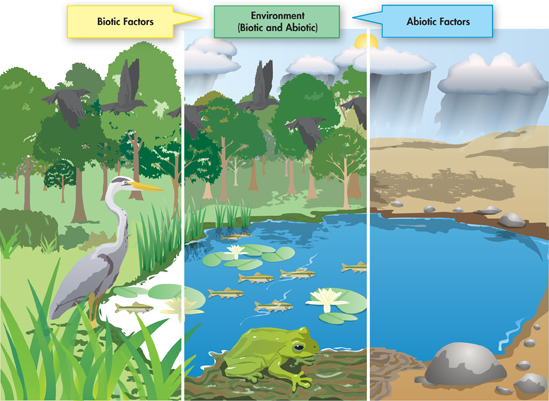Biotic and Abiotic Factors
 What are biotic and abiotic factors?
What are biotic and abiotic factors?
Ecologists use the word environment to refer to all conditions, or factors, surrounding an organism. Environmental conditions include biotic factors and abiotic factors, as shown in Figure 3–2.
Biotic Factors  The biological influences on organisms are called biotic factors. A biotic factor is any living part of the environment with which an organism might interact, including animals, plants, mushrooms, and bacteria. Biotic factors relating to a bullfrog, for example, might include algae it eats as a tadpole, insects it eats as an adult, herons that eat bullfrogs, and other species that compete with bullfrogs for food or space.
The biological influences on organisms are called biotic factors. A biotic factor is any living part of the environment with which an organism might interact, including animals, plants, mushrooms, and bacteria. Biotic factors relating to a bullfrog, for example, might include algae it eats as a tadpole, insects it eats as an adult, herons that eat bullfrogs, and other species that compete with bullfrogs for food or space.
Abiotic Factors  Physical components of an ecosystem are called abiotic factors. An abiotic factor is any nonliving part of the environment, such as sunlight, heat, precipitation, humidity, wind or water currents, soil type, and so on. For example, a bullfrog could be affected by abiotic factors such as water availability, temperature, and humidity.
Physical components of an ecosystem are called abiotic factors. An abiotic factor is any nonliving part of the environment, such as sunlight, heat, precipitation, humidity, wind or water currents, soil type, and so on. For example, a bullfrog could be affected by abiotic factors such as water availability, temperature, and humidity.

Figure 3–2 Biotic and Abiotic Factors Like all ecosystems, this pond is affected by a combination of biotic and abiotic factors. Some environmental factors, such as the “muck” around the edges of the pond, are a mix of biotic and abiotic components. Biotic and abiotic factors are dynamic, meaning that they constantly affect each other.
Classify What biotic factors are visible in this ecosystem?
dTable of Contents
- Formulas and Equations
- Applying Formulas and Equations
- Mean, Median, and Mode
- Estimation
- Using Measurements in Calculations
- Effects of Measurement Errors
- Accuracy
- Precision
- Comparing Accuracy and Precision
- Significant Figures
- Calculating With Significant Figures
- Scientific Notation
- Calculating With Scientific Notation
- Dimensional Analysis
- Applying Dimensional Analysis




